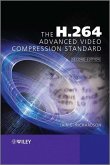

Alle Infos zum eBook verschenken

- Format: PDF
- Merkliste
- Auf die Merkliste
- Bewerten Bewerten
- Teilen
- Produkt teilen
- Produkterinnerung
- Produkterinnerung

Hier können Sie sich einloggen

Bitte loggen Sie sich zunächst in Ihr Kundenkonto ein oder registrieren Sie sich bei bücher.de, um das eBook-Abo tolino select nutzen zu können.
A comprehensive presentation of the video communication techniques and systems, this book examines 4G wireless systems which are set to revolutionise ubiquitous multimedia communication.4G Wireless Video Communications covers the fundamental theory and looks at systems' descriptions with a focus on digital video. It addresses the key topics associated with multimedia communication on 4G networks, including advanced video coding standards, error resilience and error concealment techniques, as well as advanced content-analysis and adaptation techniques for video communications, cross-layer…mehr
- Geräte: PC
- mit Kopierschutz
- eBook Hilfe
- Größe: 4.57MB
![Digital Video Distribution in Broadband, Television, Mobile and Converged Networks (eBook, PDF) Digital Video Distribution in Broadband, Television, Mobile and Converged Networks (eBook, PDF)]() Sanjoy PaulDigital Video Distribution in Broadband, Television, Mobile and Converged Networks (eBook, PDF)71,99 €
Sanjoy PaulDigital Video Distribution in Broadband, Television, Mobile and Converged Networks (eBook, PDF)71,99 €![The H.264 Advanced Video Compression Standard (eBook, PDF) The H.264 Advanced Video Compression Standard (eBook, PDF)]() Iain RichardsonThe H.264 Advanced Video Compression Standard (eBook, PDF)95,99 €
Iain RichardsonThe H.264 Advanced Video Compression Standard (eBook, PDF)95,99 €![Scalable Video on Demand (eBook, PDF) Scalable Video on Demand (eBook, PDF)]() Michael ZinkScalable Video on Demand (eBook, PDF)107,99 €
Michael ZinkScalable Video on Demand (eBook, PDF)107,99 €![LTE and the Evolution to 4G Wireless (eBook, PDF) LTE and the Evolution to 4G Wireless (eBook, PDF)]() Agilent TechnologiesLTE and the Evolution to 4G Wireless (eBook, PDF)89,99 €
Agilent TechnologiesLTE and the Evolution to 4G Wireless (eBook, PDF)89,99 €![Broadband Wireless Multimedia Networks (eBook, PDF) Broadband Wireless Multimedia Networks (eBook, PDF)]() Benny BingBroadband Wireless Multimedia Networks (eBook, PDF)98,99 €
Benny BingBroadband Wireless Multimedia Networks (eBook, PDF)98,99 €![Error Control Coding for B3G/4G Wireless Systems (eBook, PDF) Error Control Coding for B3G/4G Wireless Systems (eBook, PDF)]() Error Control Coding for B3G/4G Wireless Systems (eBook, PDF)98,99 €
Error Control Coding for B3G/4G Wireless Systems (eBook, PDF)98,99 €![Video and Multimedia Transmissions over Cellular Networks (eBook, PDF) Video and Multimedia Transmissions over Cellular Networks (eBook, PDF)]() Video and Multimedia Transmissions over Cellular Networks (eBook, PDF)107,99 €
Video and Multimedia Transmissions over Cellular Networks (eBook, PDF)107,99 €-
-
-
Dieser Download kann aus rechtlichen Gründen nur mit Rechnungsadresse in A, B, BG, CY, CZ, D, DK, EW, E, FIN, F, GR, HR, H, IRL, I, LT, L, LR, M, NL, PL, P, R, S, SLO, SK ausgeliefert werden.
- Produktdetails
- Verlag: John Wiley & Sons
- Seitenzahl: 420
- Erscheinungstermin: 1. Juni 2009
- Englisch
- ISBN-13: 9780470745175
- Artikelnr.: 37299255
- Verlag: John Wiley & Sons
- Seitenzahl: 420
- Erscheinungstermin: 1. Juni 2009
- Englisch
- ISBN-13: 9780470745175
- Artikelnr.: 37299255
Introduction. 1.1 Why 4G? 1.2 4G Status and Key Technologies. 1.2.1 3GPP
LTE. 1.2.2 Mobile WiMAX. 1.3 Video Over Wireless. 1.3.1 Video Compression
Basics. 1.3.2 Video Coding Standards. 1.3.3 Error Resilience. 1.3.4 Network
Integration. 1.3.5 Cross-Layer Design for Wireless Video Delivery. 1.4
Challenges and Opportunities for 4G Wireless Video. References. 2 Wireless
Communications and Networking. 2.1 Characteristics and Modeling of Wireless
Channels. 2.1.1 Degradation in Radio Propagation. 2.1.2 Rayleigh Fading
Channel. 2.2 Adaptive Modulation and Coding. 2.2.1 Basics of Modulation
Schemes. 2.2.2 System Model of AMC. 2.2.3 Channel Quality Estimation and
Prediction. 2.2.4 Modulation and Coding Parameter Adaptation. 2.2.5
Estimation Error and Delay in AMC. 2.2.6 Selection of Adaptation Interval.
2.3 Orthogonal Frequency Division Multiplexing. 2.3.1 Background. 2.3.2
System Model and Implementation. 2.3.3 Pros and Cons. 2.4 Multiple-Input
Multiple-Output Systems. 2.4.1 MIMO System Model. 2.4.2 MIMO Capacity Gain:
Multiplexing. 2.4.3 MIMO Diversity Gain: Beamforming. 2.4.4
Diversity-Multiplexing Trade-offs. 2.4.5 Space-Time Coding. 2.5 Cross-Layer
Design of AMC and HARQ. 2.5.1 Background. 2.5.2 System Modeling. 2.5.3
Cross-Layer Design. 2.5.4 Performance Analysis. 2.5.5 Performance. 2.6
Wireless Networking. 2.6.1 Layering Network Architectures. 2.6.2 Network
Service Models. 2.6.3 Multiplexing Methods. 2.6.4 Connection Management in
IP-Based Data Networks. 2.6.5 QoS Handoff. 2.7 Summary. References. 3 Video
Coding and Communications. 3.1 Digital Video Compression - Why and How
Much? 3.2 Basics. 3.2.1 Video Formats. 3.3 Information Theory. 3.3.1
Entropy and Mutual Information. 3.3.2 Encoding of an Information Source.
3.3.3 Variable Length Coding. 3.3.4 Quantization. 3.4 Encoder
Architectures. 3.4.1 DPCM. 3.4.2 Hybrid Transform-DPCM Architecture. 3.4.3
A Typical Hybrid Transform DPCM-based Video Codec. 3.4.4 Motion
Compensation. 3.4.5 DCT and Quantization. 3.4.6 Procedures Performed at the
Decoder. 3.5 Wavelet-Based Video Compression. 3.5.1 Motion-Compensated
Temporal Wavelet Transform Using Lifting. References. 4 4G Wireless
Communications and Networking. 4.1 IMT-Advanced and 4G. 4.2 LTE. 4.2.1
Introduction. 4.2.2 Protocol Architecture. 4.2.3 LTE Layer 2. 4.2.4 The
Evolution of Architecture. 4.2.5 LTE Standardization. 4.3 WIMAX-IEEE
802.16m. 4.3.1 Network Architecture. 4.3.2 System Reference Model. 4.3.3
Protocol Structure. 4.3.4 Other Functions Supported by IEEE 802.16m for
Further Study. 4.4 3GPP2 UMB. 4.4.1 Architecture Reference Model. 4.4.2
Layering Architecture and Protocols. Acknowledgements. References. 5
Advanced Video Coding (AVC)/H.264 Standard. 5.1 Digital Video Compression
Standards. 5.2 AVC/H.264 Coding Algorithm. 5.2.1 Temporal Prediction. 5.2.2
Spatial Prediction. 5.2.3 The Transform. 5.2.4 Quantization and Scaling.
5.2.5 Scanning. 5.2.6 Variable Length Lossless Codecs. 5.2.7 Deblocking
Filter. 5.2.8 Hierarchy in the Coded Video. 5.2.9 Buffers. 5.2.10
Encapsulation/Packetization. 5.2.11 Profiles. 5.2.12 Levels. 5.2.13
Parameter Sets. 5.2.14 Supplemental Enhancement Information (SEI). 5.2.15
Subjective Tests. References. 6 Content Analysis for Communications. 6.1
Introduction. 6.2 Content Analysis. 6.2.1 Low-Level Feature Extraction.
6.2.2 Image Segmentation. 6.2.3 Video Object Segmentation. 6.2.4 Video
Structure Understanding. 6.2.5 Analysis Methods in Compressed Domain. 6.3
Content-Based Video Representation. 6.4 Content-Based Video Coding and
Communications. 6.4.1 Object-Based Video Coding. 6.4.2 Error Resilience for
Object-Based Video. 6.5 Content Description and Management. 6.5.1 MPEG-7.
6.5.2 MPEG-21. References. 7 Video Error Resilience and Error Concealment.
7.1 Introduction. 7.2 Error Resilience. 7.2.1 Resynchronization Markers.
7.2.2 Reversible Variable Length Coding (RVLC). 7.2.3 Error-Resilient
Entropy Coding (EREC). 7.2.4 Independent Segment Decoding. 7.2.5 Insertion
of Intra Blocks or Frames. 7.2.6 Scalable Coding. 7.2.7 Multiple
Description Coding. 7.3 Channel Coding. 7.4 Error Concealment. 7.4.1 Intra
Error Concealment Techniques 7.4.2 Inter Error Concealment Techniques. 7.5
Error Resilience Features of H.264/AVC. 7.5.1 Picture Segmentation. 7.5.2
Intra Placement. 7.5.3 Reference Picture Selection. 7.5.4 Data
Partitioning. 7.5.5 Parameter Sets. 7.5.6 Flexible Macroblock Ordering.
7.5.7 Redundant Slices (RSs). References. 8 Cross-Layer Optimized Video
Delivery over 4G Wireless Networks. 8.1 Why Cross-Layer Design? 8.2
Quality-Driven Cross-Layer Framework. 8.3 Application Layer. 8.4 Rate
Control at the Transport Layer. 8.4.1 Background. 8.4.2 System Model. 8.4.3
Network Setting. 8.4.4 Problem Formulation. 8.4.5 Problem Solution. 8.4.6
Performance Evaluation. 8.5 Routing at the Network Layer. 8.5.1 Background.
8.5.2 System Model. 8.5.3 Routing Metric. 8.5.4 Problem Formulation. 8.5.5
Problem Solution. 8.5.6 Implementation Considerations. 8.5.7 Performance
Evaluation. 8.6 Content-Aware Real-Time Video Streaming. 8.6.1 Background.
8.6.2 Background. 8.6.3 Problem Formulation. 8.6.4 Routing Based on
Priority Queuing. 8.6.5 Problem Solution. 8.6.6 Performance Evaluation. 8.7
Cross-Layer Optimization for Video Summary Transmission. 8.7.1 Background.
8.7.2 Problem Formulation. 8.7.3 System Model. 8.7.4 Link Adaptation for
Good Content Coverage. 8.7.5 Problem Solution. 8.7.6 Performance
Evaluation. 8.8 Conclusions. References. 9 Content-based Video
Communications. 9.1 Network-Adaptive Video Object Encoding. 9.2 Joint
Source Coding and Unequal Error Protection. 9.2.1 Problem Formulation.
9.2.2 Solution and Implementation Details. 9.2.3 Application on
Energy-Efficient Wireless Network. 9.2.4 Application on Differentiated
Services Networks. 9.3 Joint Source-Channel Coding with Utilization of Data
Hiding. 9.3.1 Hiding Shape in Texture. 9.3.2 Joint Source-Channel Coding.
9.3.3 Joint Source-Channel Coding and Data Hiding. 9.3.4 Experimental
Results. References. 10 AVC/H.264 Application - Digital TV. 10.1
Introduction. 10.1.1 Encoder Flexibility. 10.2 Random Access. 10.2.1 GOP
Bazaar. 10.2.2 Buffers, Before and After. 10.3 Bitstream Splicing. 10.4
Trick Modes. 10.4.1 Fast Forward. 10.4.2 Reverse. 10.4.3 Pause. 10.5
Carriage of AVC/H.264 Over MPEG-2 Systems. 10.5.1 Packetization. 10.5.2
Audio Video Synchronization. 10.5.3 Transmitter and Receiver Clock
Synchronization. 10.5.4 System Target Decoder and Timing Model. References.
11 Interactive Video Communications. 11.1 Video Conferencing and Telephony.
11.1.1 IP and Broadband Video Telephony. 11.1.2 Wireless Video Telephony.
11.1.3 3G-324M Protocol. 11.2 Region-of-Interest Video Communications.
11.2.1 ROI based Bit Allocation. 11.2.2 Content Adaptive Background
Skipping. References. 12 Wireless Video Streaming. 12.1 Introduction. 12.2
Streaming System Architecture. 12.2.1 Video Compression. 12.2.2 Application
Layer QoS Control. 12.2.3 Protocols. 12.2.4 Video/Audio Synchronization.
12.3 Delay-Constrained Retransmission. 12.3.1 Receiver-Based Control.
12.3.2 Sender-Based Control. 12.3.3 Hybrid Control. 12.3.4 Rate-Distortion
Optimal Retransmission. 12.4 Considerations for Wireless Video Streaming.
12.4.1 Cross-Layer Optimization and Physical Layer Consideration. 12.5 P2P
Video Streaming. References. Index.
Introduction. 1.1 Why 4G? 1.2 4G Status and Key Technologies. 1.2.1 3GPP
LTE. 1.2.2 Mobile WiMAX. 1.3 Video Over Wireless. 1.3.1 Video Compression
Basics. 1.3.2 Video Coding Standards. 1.3.3 Error Resilience. 1.3.4 Network
Integration. 1.3.5 Cross-Layer Design for Wireless Video Delivery. 1.4
Challenges and Opportunities for 4G Wireless Video. References. 2 Wireless
Communications and Networking. 2.1 Characteristics and Modeling of Wireless
Channels. 2.1.1 Degradation in Radio Propagation. 2.1.2 Rayleigh Fading
Channel. 2.2 Adaptive Modulation and Coding. 2.2.1 Basics of Modulation
Schemes. 2.2.2 System Model of AMC. 2.2.3 Channel Quality Estimation and
Prediction. 2.2.4 Modulation and Coding Parameter Adaptation. 2.2.5
Estimation Error and Delay in AMC. 2.2.6 Selection of Adaptation Interval.
2.3 Orthogonal Frequency Division Multiplexing. 2.3.1 Background. 2.3.2
System Model and Implementation. 2.3.3 Pros and Cons. 2.4 Multiple-Input
Multiple-Output Systems. 2.4.1 MIMO System Model. 2.4.2 MIMO Capacity Gain:
Multiplexing. 2.4.3 MIMO Diversity Gain: Beamforming. 2.4.4
Diversity-Multiplexing Trade-offs. 2.4.5 Space-Time Coding. 2.5 Cross-Layer
Design of AMC and HARQ. 2.5.1 Background. 2.5.2 System Modeling. 2.5.3
Cross-Layer Design. 2.5.4 Performance Analysis. 2.5.5 Performance. 2.6
Wireless Networking. 2.6.1 Layering Network Architectures. 2.6.2 Network
Service Models. 2.6.3 Multiplexing Methods. 2.6.4 Connection Management in
IP-Based Data Networks. 2.6.5 QoS Handoff. 2.7 Summary. References. 3 Video
Coding and Communications. 3.1 Digital Video Compression - Why and How
Much? 3.2 Basics. 3.2.1 Video Formats. 3.3 Information Theory. 3.3.1
Entropy and Mutual Information. 3.3.2 Encoding of an Information Source.
3.3.3 Variable Length Coding. 3.3.4 Quantization. 3.4 Encoder
Architectures. 3.4.1 DPCM. 3.4.2 Hybrid Transform-DPCM Architecture. 3.4.3
A Typical Hybrid Transform DPCM-based Video Codec. 3.4.4 Motion
Compensation. 3.4.5 DCT and Quantization. 3.4.6 Procedures Performed at the
Decoder. 3.5 Wavelet-Based Video Compression. 3.5.1 Motion-Compensated
Temporal Wavelet Transform Using Lifting. References. 4 4G Wireless
Communications and Networking. 4.1 IMT-Advanced and 4G. 4.2 LTE. 4.2.1
Introduction. 4.2.2 Protocol Architecture. 4.2.3 LTE Layer 2. 4.2.4 The
Evolution of Architecture. 4.2.5 LTE Standardization. 4.3 WIMAX-IEEE
802.16m. 4.3.1 Network Architecture. 4.3.2 System Reference Model. 4.3.3
Protocol Structure. 4.3.4 Other Functions Supported by IEEE 802.16m for
Further Study. 4.4 3GPP2 UMB. 4.4.1 Architecture Reference Model. 4.4.2
Layering Architecture and Protocols. Acknowledgements. References. 5
Advanced Video Coding (AVC)/H.264 Standard. 5.1 Digital Video Compression
Standards. 5.2 AVC/H.264 Coding Algorithm. 5.2.1 Temporal Prediction. 5.2.2
Spatial Prediction. 5.2.3 The Transform. 5.2.4 Quantization and Scaling.
5.2.5 Scanning. 5.2.6 Variable Length Lossless Codecs. 5.2.7 Deblocking
Filter. 5.2.8 Hierarchy in the Coded Video. 5.2.9 Buffers. 5.2.10
Encapsulation/Packetization. 5.2.11 Profiles. 5.2.12 Levels. 5.2.13
Parameter Sets. 5.2.14 Supplemental Enhancement Information (SEI). 5.2.15
Subjective Tests. References. 6 Content Analysis for Communications. 6.1
Introduction. 6.2 Content Analysis. 6.2.1 Low-Level Feature Extraction.
6.2.2 Image Segmentation. 6.2.3 Video Object Segmentation. 6.2.4 Video
Structure Understanding. 6.2.5 Analysis Methods in Compressed Domain. 6.3
Content-Based Video Representation. 6.4 Content-Based Video Coding and
Communications. 6.4.1 Object-Based Video Coding. 6.4.2 Error Resilience for
Object-Based Video. 6.5 Content Description and Management. 6.5.1 MPEG-7.
6.5.2 MPEG-21. References. 7 Video Error Resilience and Error Concealment.
7.1 Introduction. 7.2 Error Resilience. 7.2.1 Resynchronization Markers.
7.2.2 Reversible Variable Length Coding (RVLC). 7.2.3 Error-Resilient
Entropy Coding (EREC). 7.2.4 Independent Segment Decoding. 7.2.5 Insertion
of Intra Blocks or Frames. 7.2.6 Scalable Coding. 7.2.7 Multiple
Description Coding. 7.3 Channel Coding. 7.4 Error Concealment. 7.4.1 Intra
Error Concealment Techniques 7.4.2 Inter Error Concealment Techniques. 7.5
Error Resilience Features of H.264/AVC. 7.5.1 Picture Segmentation. 7.5.2
Intra Placement. 7.5.3 Reference Picture Selection. 7.5.4 Data
Partitioning. 7.5.5 Parameter Sets. 7.5.6 Flexible Macroblock Ordering.
7.5.7 Redundant Slices (RSs). References. 8 Cross-Layer Optimized Video
Delivery over 4G Wireless Networks. 8.1 Why Cross-Layer Design? 8.2
Quality-Driven Cross-Layer Framework. 8.3 Application Layer. 8.4 Rate
Control at the Transport Layer. 8.4.1 Background. 8.4.2 System Model. 8.4.3
Network Setting. 8.4.4 Problem Formulation. 8.4.5 Problem Solution. 8.4.6
Performance Evaluation. 8.5 Routing at the Network Layer. 8.5.1 Background.
8.5.2 System Model. 8.5.3 Routing Metric. 8.5.4 Problem Formulation. 8.5.5
Problem Solution. 8.5.6 Implementation Considerations. 8.5.7 Performance
Evaluation. 8.6 Content-Aware Real-Time Video Streaming. 8.6.1 Background.
8.6.2 Background. 8.6.3 Problem Formulation. 8.6.4 Routing Based on
Priority Queuing. 8.6.5 Problem Solution. 8.6.6 Performance Evaluation. 8.7
Cross-Layer Optimization for Video Summary Transmission. 8.7.1 Background.
8.7.2 Problem Formulation. 8.7.3 System Model. 8.7.4 Link Adaptation for
Good Content Coverage. 8.7.5 Problem Solution. 8.7.6 Performance
Evaluation. 8.8 Conclusions. References. 9 Content-based Video
Communications. 9.1 Network-Adaptive Video Object Encoding. 9.2 Joint
Source Coding and Unequal Error Protection. 9.2.1 Problem Formulation.
9.2.2 Solution and Implementation Details. 9.2.3 Application on
Energy-Efficient Wireless Network. 9.2.4 Application on Differentiated
Services Networks. 9.3 Joint Source-Channel Coding with Utilization of Data
Hiding. 9.3.1 Hiding Shape in Texture. 9.3.2 Joint Source-Channel Coding.
9.3.3 Joint Source-Channel Coding and Data Hiding. 9.3.4 Experimental
Results. References. 10 AVC/H.264 Application - Digital TV. 10.1
Introduction. 10.1.1 Encoder Flexibility. 10.2 Random Access. 10.2.1 GOP
Bazaar. 10.2.2 Buffers, Before and After. 10.3 Bitstream Splicing. 10.4
Trick Modes. 10.4.1 Fast Forward. 10.4.2 Reverse. 10.4.3 Pause. 10.5
Carriage of AVC/H.264 Over MPEG-2 Systems. 10.5.1 Packetization. 10.5.2
Audio Video Synchronization. 10.5.3 Transmitter and Receiver Clock
Synchronization. 10.5.4 System Target Decoder and Timing Model. References.
11 Interactive Video Communications. 11.1 Video Conferencing and Telephony.
11.1.1 IP and Broadband Video Telephony. 11.1.2 Wireless Video Telephony.
11.1.3 3G-324M Protocol. 11.2 Region-of-Interest Video Communications.
11.2.1 ROI based Bit Allocation. 11.2.2 Content Adaptive Background
Skipping. References. 12 Wireless Video Streaming. 12.1 Introduction. 12.2
Streaming System Architecture. 12.2.1 Video Compression. 12.2.2 Application
Layer QoS Control. 12.2.3 Protocols. 12.2.4 Video/Audio Synchronization.
12.3 Delay-Constrained Retransmission. 12.3.1 Receiver-Based Control.
12.3.2 Sender-Based Control. 12.3.3 Hybrid Control. 12.3.4 Rate-Distortion
Optimal Retransmission. 12.4 Considerations for Wireless Video Streaming.
12.4.1 Cross-Layer Optimization and Physical Layer Consideration. 12.5 P2P
Video Streaming. References. Index.







